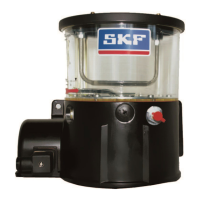Page 62
EN
6.3.3.3 Monitoring lubrication cycle via
piston detector
The progressive feeders installed on the lubri-
cation system are supplied with lubricant sev-
eral times during the pump cycle. They then
deliver the lubricant to the lubrication point.
The complete piston movement of a progres-
sive feeder forward and back to the normal
position is also called a cycle. The piston move-
ment can be detected via a contact switch,
a "piston detector," which sends the corre-
sponding signals to the control unit. There, the
signals are registered and evaluated.
The number of cycles which must occur before
in order to monitor the lubrication cycle and
points.
whether the pump cycle should be ended after
has been reached or whether the pump should
value or number of pulses (revolutions of the
agitator) is reached.
pulses is not reached during the pump cycle,
the control unit reacts by starting block opera-
tion.
In contrast with the KFGS pump unit, the KFGC
(CAN bus) design can repeat the lubrication
cycle as often as desired.
reached during the repeat lubrication cycle, the
pump unit switches back to normal operation.
If the set number of piston detector signals is
not reached during block operation, the control
unit switches off the affected lubrication zone
or the entire lubrication system and issues a
6.3.3.4 Monitoring signal cables for cable
breakage and monitoring valves and
piston detectors
piston detector to the control unit is constantly
monitored for cable breakage.
On a lubrication system with multiple zones,
the piston detector assigned to a zone is
queried before the zone valve is opened. If the
piston detector is not found, the control unit
assumes a cable has been broken. In this case,
zone is then deactivated until the piston detec-
tor fault is resolved.
Block operation is not initiated.
On a system without multiple lubrication
zones, the unit is fully deactivated after the
Chapter 15.2).
6. Functional description in progressive systems
KFGC

